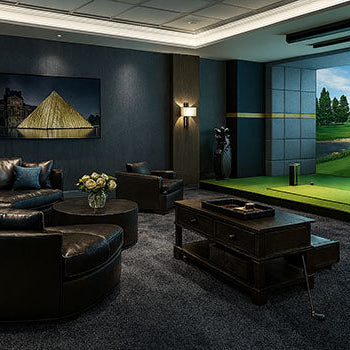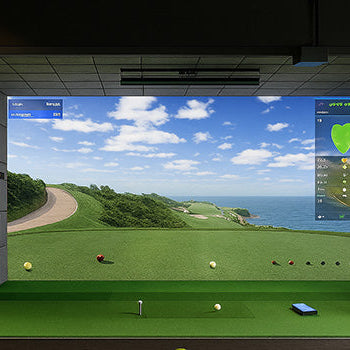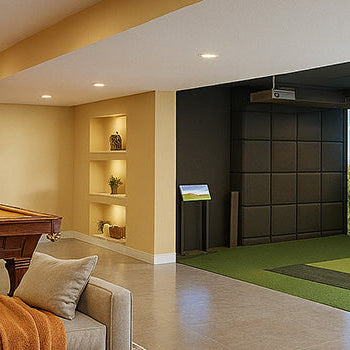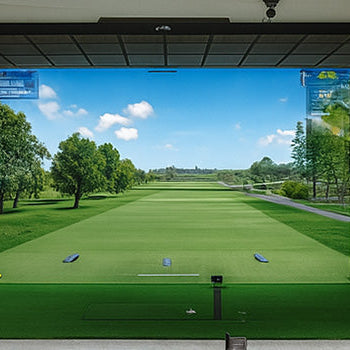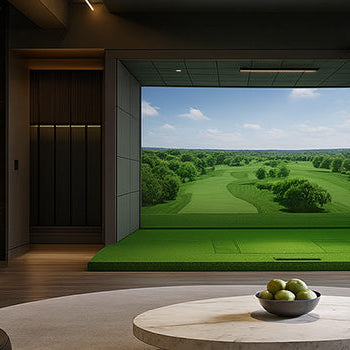Before your Golf Simulator turns your ceiling into Swiss cheese, do yourself a favour. Add some solid overhead protection. The quick fix? Netting, foam, or proper ceiling panels.
Keep reading to discover smart DIY options, pro-grade solutions, and easy ways to stop a rogue shot from causing chaos. It’s time to protect your ceiling, and your peace of mind.

Why Ceiling Protection is a Non-Negotiable Part of Your Build
The Dangers of a "Sky Ball" or Popped-Up Shot
Ever hit under the ball and watched it launch like a missile? That’s a sky ball, and in a simulator, there’s no open sky to catch it.
Whether you’re a weekend warrior or a scratch golfer, these unexpected shots are more common than you'd think. All it takes is a bad lie or misjudged wedge shot to send the ball flying straight into your ceiling.
One mistake, one hole in your plasterboard. That's all it takes.
Protecting Your Home and Preventing Injury
Golf balls aren’t soft. At full swing speed, they hit like a sledgehammer in disguise.
Ceilings take the brunt of those misfires, and without padding, that’s a recipe for cracks, dents, or worse, dangerous ricochets. Especially in smaller home setups, a wild shot can rebound and hit walls, TVs, or even you.
Safety first, every time. It’s better to overprotect than underprepare.
Peace of Mind for a Freer, More Confident Swing
Worried about hitting the ceiling? You'll start pulling punches mid-swing, and that's not good for your form.
When your space is protected, you can swing with confidence. No hesitation, no flinching, just clean shots.
Proper ceiling protection gives you the mental freedom to swing fully and fearlessly.
Solution 1: The Enclosure Itself
How a Quality Golf Simulator Enclosure Has a Built-in Roof
A lot of high-quality golf simulator enclosures come with a roof or top netting built in. These aren’t just nice extras—they’re essential safety features.
If you're buying an enclosure kit, check if it includes overhead protection. Some cheaper options skip it to cut costs, but it's a crucial component.
The Importance of a Baffled or Angled Roof Design
Not all ceilings are created equal. A baffled or angled top helps redirect high shots downward, which reduces direct impact and improves safety.
This design isn’t just practical. It can actually improve your simulator’s look and feel too.
Checking for Gaps Between the Screen and the Ceiling
Even a small gap between your screen and ceiling is a problem. That’s where sky balls escape, and where your ceiling gets hammered.
Before your first swing, seal or shield that space. Some users use soft fabric baffles or additional netting. It’s a small touch that makes a big difference.

Solution 2: Memory Foam Floor Tiles
A Simple and Cost-Effective DIY Method
Looking for a budget-friendly DIY ceiling solution? Here’s a clever hack: use memory foam gym tiles, the kind you’d normally step on, to pad your ceiling.
They’re light, cushiony, and you can find them in any sports or home store. It’s one of the most affordable ways to soften overhead impacts.
How to Secure Interlocking Gym Tiles to Your Ceiling
Mounting them is easier than it sounds. Most DIYers use strong adhesive strips or screws with large washers to distribute weight.
Just make sure the tiles stay snug against the ceiling and won’t come loose during a hot summer or cold winter. Overhead padding has to stay put.
The Pros and Cons of Using Foam Tiles
Pros: Cheap, lightweight, easy to install. Great for DIY beginners.
Cons: Not as durable as pro panels. Can look bulky or uneven.
Still, for £50–£150, foam tiles are a solid temporary fix that’ll save your ceiling from a beating.
Solution 3: Acoustic Panelling
How Studio Sound Panels Can Absorb Ball Impact
Acoustic panels aren’t just for music studios, they’re excellent at absorbing golf ball impact. These dense foam or fabric-covered panels take the sting out of wayward shots.
They’re built to soak up energy and stop bounce-backs in their tracks.
The Added Benefit of Sound Dampening
Let’s be honest, golf simulators can be loud. Especially in smaller rooms with echo.
Acoustic panels do double duty: they protect your ceiling and reduce noise. That’s a win-win if you’re in a shared house or don’t want to wake the neighbours.
Installation Tips for Acoustic Panels
They’re super easy to mount. Use heavy-duty Velcro, 3M strips, or screws with decorative washers.
Start by covering the area right above your hitting zone, then expand outward. Keep the spacing tight for maximum safety.
Solution 4: Heavy-Duty Netting or Archery Baffles
Creating a Secondary Safety Net Above Your Hitting Area
Think of this like a goalie for your ceiling. Heavy-duty golf netting or archery baffles hang just above your hitting zone and catch any ball that tries to go vertical.
Even if you already have padding, this acts as a second line of defence.
Where to Source and How to Hang Impact Netting
You can find golf simulator netting online or at sports retailers. Look for tight-weave, high-tensile nylon or polyester mesh.
To hang it, use wall anchors and ceiling hooks, or tension rods if you want something temporary. Just make sure it’s tight and sag-free.
The Professional Choice for Ultimate Protection
Pro setups often use netting combined with foam ceiling panels. Why? Because it’s the most effective combo.
It catches the ball and softens the blow. It also looks clean and keeps your space safe even during intense sessions.

Final Safety Checks Before You Take Your First Swing
You’ve done the hard work, now double-check it all before you grab your driver.
-
Are all impact zones padded or protected?
-
No visible gaps between screen and ceiling?
-
Fixtures like lights and alarms shielded?
-
Panels and netting securely installed?
A few minutes of final inspection can save you from major repairs later. Don’t skip it.
Proper golf sim wall padding and ceiling protection make your setup safer, quieter, and more enjoyable.
